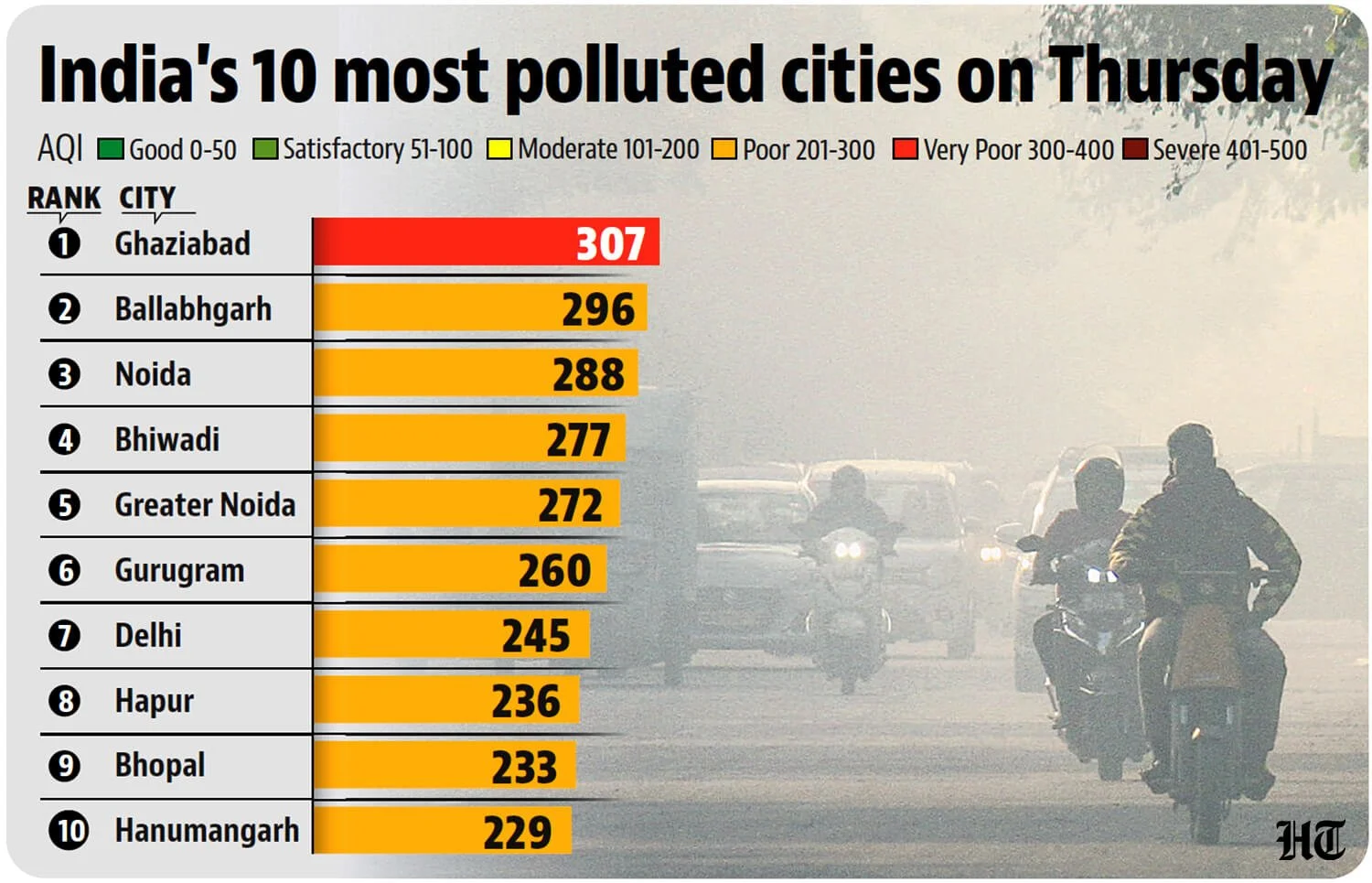Hazed and confused: NCR cities top country’s most polluted list
An all-too-familiar haze has returned to the National Capital Region (NCR) on Thursday, cloaking Delhi and its suburbs in a thick blanket of pollution even before Diwali’s firecracker emissions compound the crisis.
Data from the Central Pollution Control Board’s Thursday bulletin delivered a stark reality check: the top eight most polluted cities in India were all in the NCR, painting a grim picture of what lies ahead as temperatures drop and meteorological conditions turn unfavourable in coming weeks.
Ghaziabad gained the notorious distinction of being India’s most polluted town on Thursday, topped the list with an Air Quality Index (AQI) of 307 – categorised as “very poor.” Ballabhgarh, near Faridabad, followed with 296, Noida with 288, and Greater Noida with 272. Gurugram recorded 260, while Delhi stood seventh with an AQI of 245 – its worst reading of the season so far and the third consecutive day of “poor” air.
On Wednesday, Noida’s air was the foulest in the country, touching 318 in the “very poor” range. Data from multiple monitoring stations in Ghaziabad showed the city blanketed by consistent pollution – Loni recorded an AQI of 339, while Indirapuram and Vasundhara were at 305. Even the relatively cleaner Sanjay Nagar remained “poor” at 280. Particulate matter (PM10) was the dominant pollutant, driven by road dust and vehicular emissions.
In Delhi, five of 39 monitoring stations were in the “very poor” bracket – Anand Vihar (360) was the worst, followed by Wazirpur (352). Noida’s Sector 125, home to several construction sites and office complexes, touched 344, while Greater Noida’s Knowledge Park V recorded 283.
Experts said the current conditions are being fuelled by a perfect storm of meteorological and human factors – calm winds, a gradual drop in night-time temperatures, and traffic congestion that traps pollutants near the surface.
“Winds are becoming calm at night, and temperatures are dipping, leading to accumulation of pollutants,” said Mahesh Palawat, vice president at Skymet. “These conditions will persist through Diwali, so firecracker emissions will only worsen the situation.”
The India Meteorological Department (IMD) said that haze is expected over the next two days, with smog likely to set in over the region by Sunday.
The minimum temperature in Delhi dropped to 18.1°C on Thursday, the lowest this season, and is forecast to fall further to 17°C on Friday. Ghaziabad and Gautam Budh Nagar recorded similar lows. “As the air cools, pollutants get trapped near the surface. If wind speed remains low, dispersion becomes very difficult,” said a senior IMD scientist.
Forecasts by the Air Quality Early Warning System (AQEWS), under the Union ministry of earth sciences, predict that Delhi’s air will deteriorate further. “Air quality is likely to remain in the ‘poor’ range till October 19 and slip into ‘very poor’ by October 20 and 21,” it stated.
The Decision Support System (DSS), another model under the ministry, showed that stubble burning’s contribution to Delhi’s PM2.5 was around 0.76% on Thursday – up from 0.2% a day earlier – and is forecast to rise to nearly 6.5% by the weekend as northwesterly winds bring smoke from Punjab and Haryana. This is likely to worsen the pollution further.
Delhi’s transport sector remains the biggest local contributor, accounting for 18.7% of PM2.5 emissions, followed by Gurugram and Sonipat.
Residents said the change is already palpable. “The evenings are cooler, but there’s a haze that stings your eyes,” said Nidhi Singh, a resident of Sector 46, Noida. “You can tell winter pollution has arrived – we haven’t even reached Diwali yet.”
Authorities, meanwhile, have stepped up visible measures. In Ghaziabad, the pollution control board said it has doubled the frequency of road sprinkling from twice to four times a day. Construction sites are being inspected for dust norms, and enforcement teams have been directed to penalise open burning.
Still, experts warn that such actions only scratch the surface.
“This is a yearly phenomenon driven primarily by meteorology,” said Sunil Dahiya, founder of the think-tank Envirocatalysts. “But the real issue lies in unchecked emissions from vehicles, industries, and waste burning. Unless those are curtailed at the source, no amount of sprinkling or firefighting will make a visible difference.”


